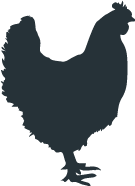Avian leukosis refers to several leukaemia-like proliferative diseases caused by the avian leukosis virus (ALV). ALVs consist of 10 subgroups designated A to J. 6 of the 10 affect chickens. Subgroups A and B are the most common, especially in egg laying hens, followed by subgroup J which occurs in broilers and egg laying hens. Subgroup E viruses are not oncogenic, and are widely present in non-commercial domestic chickens. The general forms of disease associated with avian leukosis virus include:
- Lymphoid leukosis: Lymphoid leukosis is the most common type of cancer caused by the ALV in chickens. It occurs in chickens four months of age or older. Tumors often develop in the liver, spleen, and bursa of Fabricius. Less commonly, the kidney, lung, gonad, heart, mesentery, and bone marrow. Tumor growth may be nodular, miliary, diffuse, or a combination of these forms. The bursa of Fabricius is usually always involved. Microscopically diagnostic features are the uniform large lymphocytes (lymphoblasts) that comprise the tumors, the presence of intrafollicular tumors in the bursa, and the tendency for the tumors in other tissues, such as the liver and spleen, to grow in an expansive nodular fashion.
- Erythroblastosis (Erythroid leukosis): Erythroblastosis is an intravascular erythroblastic leukemia which can occur in birds younger than 4 months old. It can affect chickens as young as five weeks old and in adults. Infected chickens are often anemic, with muscle hemorrhages and occasionally abdominal hemorrhage and ruptured liver.
- Myeloid leukosis: Myeloid leukosis, caused by subgroup J, occurs in two, often overlapping forms referred to as myeloblastosis (myeloblastic myeloid leukosis) and Myelocytomatosis (myelocytic myeloid leukosis). Myelocytomatosis causes multiple masses (myelocytomas) on the chicken’s shanks, head, and oral cavity, trachea, and eye. The tumors are usually nodular and multiple, with a soft, friable consistency and of creamy color. This form of cancer occurs mainly in adult chickens, but sometimes in birds as young as five weeks of age. Both myeloblastic and myelocytic forms are often marked by leukaemia, and bone marrow becomes replaced by neoplastic myeloid cells.
- Avian Osteopetrosis: Avian osteopetrosis, also referred to as marble bone disease, alters the growth and differentiation of osteoblasts, resulting in uniform or irregular diaphyseal or metaphyseal thickening, usually in the long bones of the legs, and less frequently the wings.
A variety of other tumors have been associated with ALV, including hemangiomas, histiocytic sarcomas, nephroblastomas, fibrosarcomas, chondromas, osteomas, myxomas, adenocarcinomas, mesotheliomas. These tumors can occur alone or with the leukoses.
Clinical Signs of Avian Leukosis
Clinical signs of avian leukosis depend on the form of the disease and location/type of tumors. The presenting signs for most forms of the disease are non-specific, and include loss of appetite, diarrhea, dehydration, emaciation, and weakness. Abdominal enlargement, and pale shriveled, or occasionally cyanotic (purple/bluing) comb may also occur. Once clinical signs develop, the course of the disease is usually rapid, and birds die within a few weeks.
Marek's disease is a similar tumor-causing viral disease that is also very common in chickens. However, Marek's disease primarily affects chickens younger than 4 months of age. Avian leukosis usually occurs in adult chickens, 4 months of age or older.
Transmission
Avian leukosis virus is transmitted horizontally (from bird to bird by direct or indirect contact) and vertically (from infected hens to their offspring through the egg). Most chicks are infected by close contact with infected chickens, which shed the virus in their feces, saliva, scales, and flakes of skin. ALV does not survive for very long in the environment, as it has a relatively short life span outside of the bird.
Diagnosis
Virus isolation is generally the ideal detection method (so-called gold standard). Samples most commonly used for detection of ALV include blood, plasma, serum, meconium, cloacal and vaginal swabs, oral washings, egg albumen, embryos, and tumors. The ELISA-ALV is the most commonly used test. Although gross appearance of the tumor can provide indications as the nature of the neoplasm, histopathological diagnosis is essential for accurate diagnosis of leukosis. The most useful tissues to collect are the liver, spleen, bursa of Fabricius, bone marrow, or peripheral nerves.
